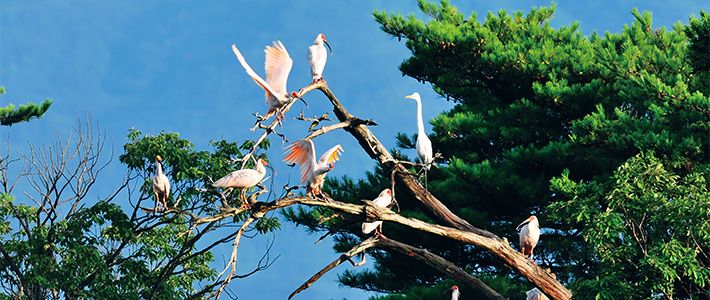
Remarkable Recovery: The Modern History of Japan’s Environment
Rediscovery and Recovery of the Crested Ibis
Environment Society- English
- 日本語
- 简体字
- 繁體字
- Français
- Español
- العربية
- Русский
Habitat and Ecology
There are 25 ibis species throughout the world, 6 of which, including the crested ibis, are designated as endangered. The crested ibis measures 70 to 80 centimeters in height, boasts a wingspan of 130 to 160 centimeters, and has a bill 15 to 18 centimeters long. The male weighs between 1.8 and 2 kilograms. The female is slightly smaller. The exposed skin on the birds’ face and legs is red in color.
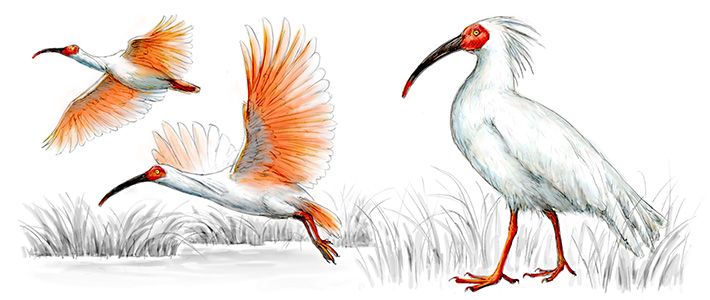 Crested ibis (Nipponia nippon). Order Pelecaniformes, family Threskiornithidae. Formerly widely distributed across the Korean Peninsula, China, and Japan, their numbers have dropped considerably and the species is now endangered. Designated a special natural monument in Japan and internationally protected. (Illustration by Izuka Tsuyoshi)
Crested ibis (Nipponia nippon). Order Pelecaniformes, family Threskiornithidae. Formerly widely distributed across the Korean Peninsula, China, and Japan, their numbers have dropped considerably and the species is now endangered. Designated a special natural monument in Japan and internationally protected. (Illustration by Izuka Tsuyoshi)
Crested ibises generally form groups of up to a dozen or so. They lay three to four eggs in early April in nests measuring around 60 centimeters across. The crested ibis is extremely nervous during breeding season and will abandon its nest if humans or other predators approach too close.
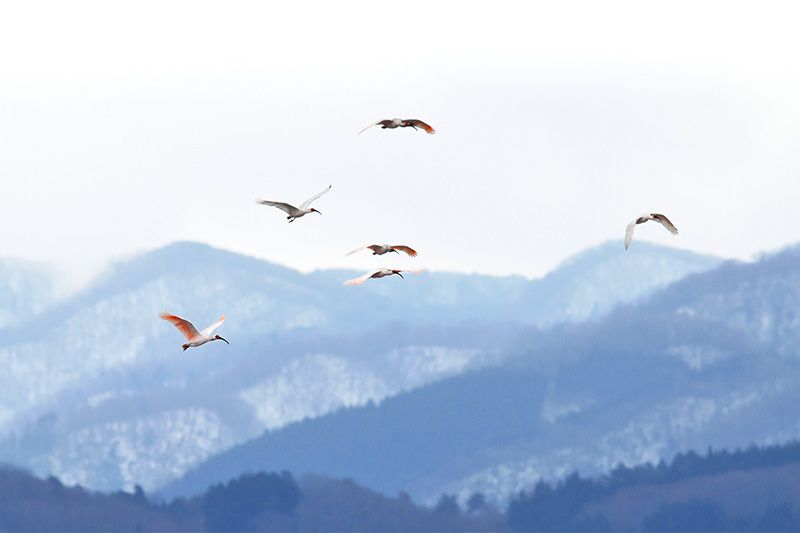 The distinguishing pink of the crested ibis’s wings is especially beautiful against the background of first snow.
The distinguishing pink of the crested ibis’s wings is especially beautiful against the background of first snow.
Toki-iro is a traditional Japanese color originating in the delicate orange-tinted pink of the crested ibis’s plumage, but the color is rarely referred to today. The tint appears on the flight and tail feathers during the nonbreeding seasons when the crested ibis’s plumage is mostly white. As breeding season approaches around late January, the ibis’s upper neck skin turns a dark shade and grows crusty. When the ibis rubs its back with its head, black particles are transferred to the feathers, turning them a dark gray in a highly unusual type of color change distinct to the crested ibis.
A Colony Discovered on Sado Island
In 1930, Gotō Yosaku of the village of Niibo—now part of the city of Sado on Niigata’s Sado Island—announced that he had seen live crested ibises in the Sado mountains.
The newspaper reports of the sighting brought a rush of ornithologists and government officials to Sado to carry out a major search. The birds’ existence was confirmed, and in 1933, crested ibises were sighted building nests near Niibo. There are believed to have been 60 to 100 birds at the time of this rediscovery. In 1934, the crested ibis was declared a natural monument, a status that was elevated to special natural monument in 1952.
With the outbreak of World War II, the crested ibis disappeared from sight. Fuel was scarce during and immediately after the war, and whole forests were felled for firewood and charcoal throughout Japan, including on Sado.
Around 1930, Takano Takaji, a Niibo village farmer, had counted as many as 27 crested ibises feeding in the rice paddies, but every year their numbers dwindled. With the hillsides shorn of their forest cover from the 1940s onward, the once-sheltered creeks where the ibises would normally feed were buried in snow in the winter. Takano surmised that this was what drove them to the rice paddies. Taking pity on their plight, he searched for freshwater crabs and frogs and released them into the paddies. He was soon joined by others bringing food for the ibises. For nearly 25 years, from 1950 to around 1975, Takano and the other villagers were able to maintain a small colony of 10 to 20 crested ibises.
Death of the Last Wild Bird
Back in the 1920s, there were many ibises to be found in the Oki Islands of Shimane Prefecture, but here, too, they had disappeared by 1950, their numbers decimated by hunting and development.
Another habitat was the Noto Peninsula. In 1929, the existence of crested ibises was confirmed on the slopes of the mountain Bijōzan. A decade later, a colony of 17–18 crested birds was discovered. By 1964, however, only one crested ibis remained. Dubbed “Nori,” this one ibis was captured in 1970 and taken to the Sado Japanese Crested Ibis Conservation Center. At this point, there was one ibis in captivity and only 10 known to live in the wild.
In 1965, an attempt was launched to raise two fledglings that had been captured on Sado. By the next year, however, one of the birds had died, and an autopsy revealed that there were pesticides in its tissues. This led, in 1967, to the building of the Sado Japanese Crested Ibis Conservation Center in the Shimizudaira area of the island, providing a place where uncontaminated feed could be provided to the remaining fledgling.
Global Alarm over Possible Extinction
By this time, preservation of the species had become a global issue. Conservationists around the world fretted that the Japanese crested ibis might soon disappear from the face of the earth.
In 1979, S. Dillon Ripley, president of the International Council for Bird Preservation (now Bird Life International) sent a letter to Ōhira Masayoshi, the prime minister at the time, urging Japan to capture and rear in captivity adult crested ibises so as to preserve the species from extinction.
A similar letter was sent to the Japanese Environment Agency by the International Union for Conservation of Nature.
After much debate as to whether the crested ibises should be fostered in captivity or conserved in the wild, where they could remain in their natural habitat, the Environment Agency opted for breeding the birds in captivity. In 1981, the last five wild crested ibises (one male and four females) on Sado Island were captured and brought to the Conservation Center, marking the final demise of the wild crested ibis population in Japan. The birds died very soon thereafter, however, leaving only the female ibis named Kin.
Good News from China
On June 29, 1981, the gloom in the Conservation Center was dispelled by good news from the Xinhua News Agency. Seven wild crested ibises, including fledglings, had been discovered in the mountains of China’s Shaanxi Province. The Institute of Zoology of the Chinese Academy of Sciences had been conducting a survey to confirm the extinction of the crested ibis when the survey team discovered a group of seven ibises, comprising two adult pairs and three fledglings, on May 23. These birds were to save the species from extinction.
With the seven ibises, the Chinese launched the world’s first successful program of breeding in captivity at the Beijing Zoo. Later five additional breeding centers were built, three in Shaanxi and one each in Henan and Zhejiang Provinces.
It was confirmed that the Chinese and Japanese crested ibises were genetically of the same species, verifying the theory that some must have migrated regularly between Japan and China at one time. In 1985, one of the Chinese birds, a male named Huahua, was loaned to the Sado Japanese Crested Ibis Conservation Center in an attempt to breed with the Japanese female, Kin, but the attempt failed. Japanese-born crested ibises went extinct with Kin’s death in 2003.
The successful breeding program in China had strong support from the Chinese government. The crested ibis sanctuary in Yangxian, Shaanxi Province, is a vast expanse of 380 square kilometers. Once the sanctuary was established, the Yangxian authorities issued a series of ordinances prohibiting the use in the region of chemical fertilizers and other agricultural chemicals, as well as any work using explosives in local mines.
Today, the number of crested ibises in China has burgeoned to more than 2,000, including both artificially bred birds and those born in the wild. Half that number are now living in natural habitats, with ibises released from captivity and those born in the wild dispersed throughout the 15,000 square kilometers of Shaanxi Province.
The Chinese Ibis to the Rescue
When Chinese President Jiang Zemin visited Japan and met with the emperor in 1998, he promised the gift of a pair of Chinese crested ibises. The next year, 1999, the male Youyou and the female Yanyan arrived at Niigata Airport and were transferred to the Sado Japanese Crested Ibis Conservation Center for artificial breeding. Kin was still alive at this time, but was too old to breed.
Three more ibises were brought to Japan on loan from China with the promise that half of any of the young born to them would be returned to China. As of 2016, a total of 47 crested ibises originating from these three had been returned to China on seven different occasions. The first chick hatched in May 1999 and was named Yuuyuu from a selection of names solicited form the public. This was the first successful hatching from artificial incubation at the Conservation Center. The event was big news—the ibis was chosen to grace the ¥1,000 silver coin specially minted to commemorate the sixtieth anniversary of the promulgation of the Local Autonomy Act.
In 2000, a female ibis named Meimei was brought on loan from China to mate with Yuuyuu. Youyou and Yanyan, along with Yuuyuu and Meimei, were the pioneers of the effort to restore Japan’s crested ibis population. By 2007, these two pairs had produced 100 children and grandchildren.
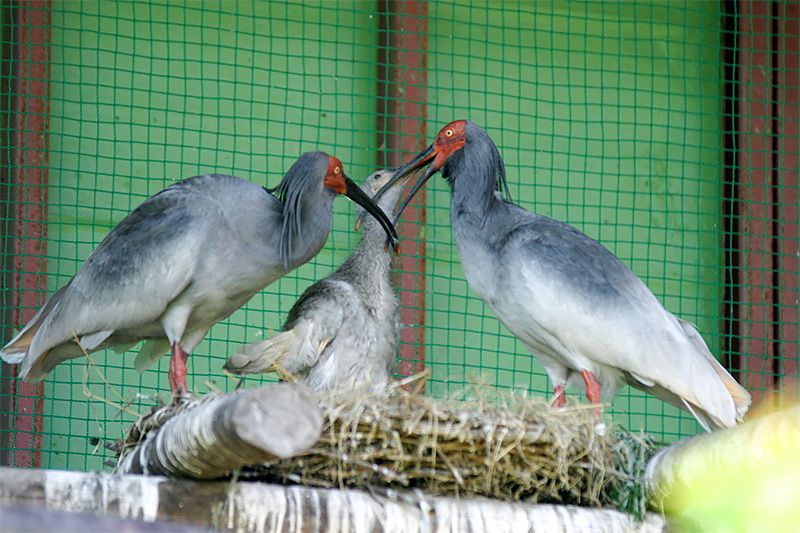 Yuuyuu (on left) and Meimei take care of a hatchling. They are the first pair to successfully breed at the Sado Japanese Crested Ibis Conservation Center. (Photo courtesy the center; ©Jiji)
Yuuyuu (on left) and Meimei take care of a hatchling. They are the first pair to successfully breed at the Sado Japanese Crested Ibis Conservation Center. (Photo courtesy the center; ©Jiji)
As of October 2016, there were a total of 173 crested ibises at the Sado Japanese Crested Ibis Conservation Center and the Sado Reintroduction Center. The Ministry of the Environment hopes to increase the number of crested ibises on Sado Island to 220 by the year 2020.
Estimated Wild Crested Ibis Populations (as of August 23, 2016)
| Released | Born in the wild (no leg bands) | Born in 2013 | Born in 2014 | Born in 2015 | Born in 2016 | Total | |
|---|---|---|---|---|---|---|---|
| Totals | 233 | 42 | 4 | 16 | 9 | 28 | |
| Believed alive | 118 | 32 | 4 | 10 | 7 | 28 | 199 |
| Considered missing | 12 | 4 | – | – | 2 | – | 18 |
| Considered dead | 83 | 5 | – | 5 | 93 | ||
| Confirmed dead (actual body count) | 17 | 1 | – | 1 | 19 | ||
| Protected in captivity | 3 | – | – | – | 3 |
Notes: “Considered missing” means no sightings for 6 months to less than 12 months. “Considered dead” refers to no sightings for a year or more. Numbers for ibises born in the wild (no leg bands) are estimates.
Release into the Wild
Starting in 2007, captive ibises were placed in an “adaptation enclosure” to prepare them for release. On September 25, 2008, the first 10 ibises, each with a leg band, were released in the mountainous Kosado area of Sado Island. The released birds formed pairs, built nests, and even laid eggs, but the eggs were either infertile or targeted by crows, and no young hatched.
In March 2010, a marten infiltrated the adaptation enclosure, killing nine and wounding one of the 10 ibises in the enclosure. By 2012, however, a series of successful hatchings of eggs laid in the wild by released crested ibises resulted in eight fledglings. In 2016, an additional 17 crested ibises were released into the wild.
Since their release, a number of ibises have made their way from Sado to the prefectures of Nagano, Toyama, Ishikawa, Fukui, Yamagata, Akita, Miyagi, and Fukushima on the main island of Honshū. Eventually, the day may come when crested ibises will be found throughout Japan as in the days of old.
Chinese Birds in South Korea
China has gifted crested ibises to South Korea as well as Japan, and the crested ibis is counted with the giant panda as an important part of China’s “animal diplomacy.” In October 2008, Chinese President Hu Jintao gave a breeding pair to South Korea. The birds traveled by chartered plane to the Ibis Restoration Center in Changnyeong, South Gyeongsang. Four chicks hatched the next year; by 2016, the number of ibises at the South Korean Restoration Center had increased to 171. Plans are underway to release some of these to the wild in 2017.
A Crested Ibis Landscape
The island of Sado is shaped like the letter “Z,” with two mountain ranges more than 1,000 meters high running in parallel south to north and enclosing the Kuninaka plain between them. This area, covered with rice paddies, is a feeding ground for the crested ibis. Before a recent visit to the island, I phoned Tsuchiya Masaoki, vice-chair of the Sado Toki Hogokai (a preservation society active on the island), to ask if I would have a chance to see some wild crested ibises. “They’re all over the place,” he replied. And sure enough, I saw at least 20 birds on a one-hour drive through the rice paddies of the plain.
This commonplace sight has only been achieved through much hard work and the devotion of the local island residents to the crested ibis. Residents report regularly and in great detail on their sightings of ibises to an Environment Ministry monitoring team. Should a car with a non-island license plate start to chase the crested ibises to photograph them, a local person is certain to step in and put a halt to this threatening behavior. The residents hover protectively over their charges and speak often of “paying attention while seeming not to.”
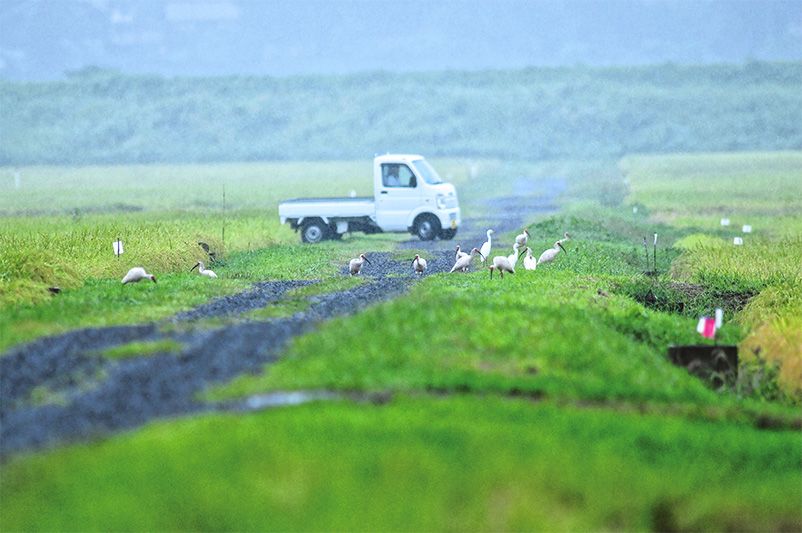 Keeping quiet watch over a flock of the birds.
Keeping quiet watch over a flock of the birds.
After the rice is harvested, deep grooves are carved into the drained paddies with tractors. A variety of living creatures congregate in the water that collects in the grooves, providing food for the crested ibises. Every effort is made not to use pesticides or chemical fertilizers in the paddies. The residents also have strict rules not to approach nests or chase the birds. Says Tsuchiya, “People wouldn’t be so interested in Sado if we didn’t have the crested ibises. We may have saved them, but now they are saving us.”
(Originally published in Japanese on April 11, 2017. Banner photo: Crested ibises in August are joined by a lone great egret, the white bird with extended neck. Photos © Tsuchiya Masaoki except where otherwise noted.)